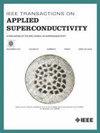Influence of Quench Position on Quench Behaviors of Parallel-Wound No-Insulation HTS Coils
IF 1.7
3区 物理与天体物理
Q3 ENGINEERING, ELECTRICAL & ELECTRONIC
引用次数: 0
Abstract
Parallel-wound No-insulation (PWNI) high-temperature superconducting (HTS) coil wound with parallel-stacked tapes is a prospective choice for fast ramping and high thermal stability magnet, which has been applied to the development of high-field toroidal field demo magnets by MIT/CFS and Tokamak Energy. Previous studies have analyzed the enhanced thermal stability of the PWNI HTS coil and its underlying mechanism, while they focus on a single initial hotspot position. This study is to illustrate quench behaviors of PWNI HTS coils under different initial quench positions, including different parallel-stacked tapes and different turns near terminal joints. A Multiphysics model combining the equivalent circuit network model of PWNI coils, FEM heat transfer module, and T-A model is used to calculate the electromagnetic and thermal properties. Results show that a counterclockwise coupling current is induced on turns without normal zone, regardless of the initial local quench positions, which is an inherent characteristic of PWNI HTS coils. This induced coupling current increases with the initial quench position moving outwards. Specifically, the maximum current in the coil with a heat disturbance near the outer terminal is approximately 1.2 times that near the inner terminal, enhancing the potential risk of overcurrent quench. Moreover, local hotspots initiating near the terminal joints (the high-risk area in magnets) result in a higher temperature rise, with a peak temperature reaching up to 1.3 times of that in PWNI coils with local hotspots initiating on middle turns.求助全文
约1分钟内获得全文
求助全文
来源期刊

IEEE Transactions on Applied Superconductivity
工程技术-工程:电子与电气
CiteScore
3.50
自引率
33.30%
发文量
650
审稿时长
2.3 months
期刊介绍:
IEEE Transactions on Applied Superconductivity (TAS) contains articles on the applications of superconductivity and other relevant technology. Electronic applications include analog and digital circuits employing thin films and active devices such as Josephson junctions. Large scale applications include magnets for power applications such as motors and generators, for magnetic resonance, for accelerators, and cable applications such as power transmission.
 求助内容:
求助内容: 应助结果提醒方式:
应助结果提醒方式:


